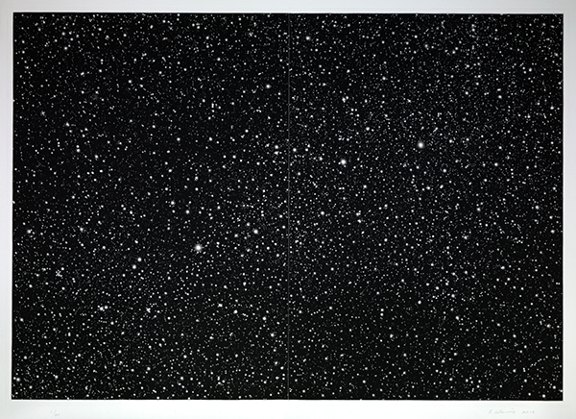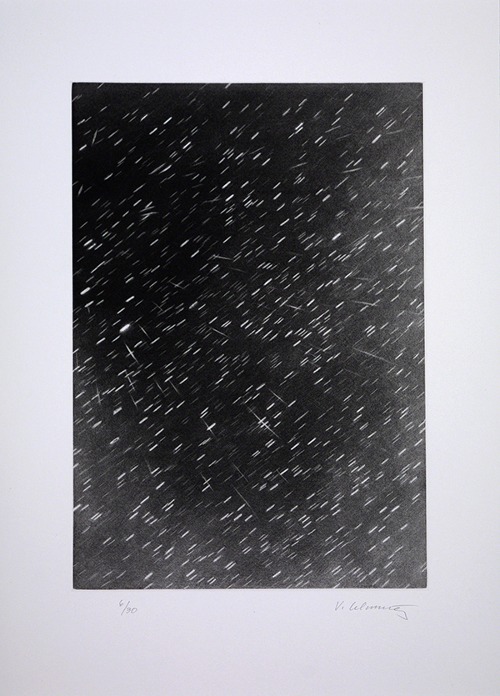Seeing Stars: Vija Celmins
The recent eclipse gave me a hankering for some art that is space oriented. I naturally thought of these prints by Vija Celmins. I’ve always been amazed by the patience that her brand of realism must require to achieve such details. Having drawn science fiction comics, I know how hard it is to add a starfield with a brush and white gouache. Producing a meticulous starfield in the intaglio printmaking medium must have the artist tearing her hair out. And yet, the result is frankly amazing.
 |
| Vija Celmins (born 1938, Latvia/U.S.), Starfield, 2010. Two-plate mezzotint on two sheets of paper, 26 ½" x 35 ⅛" (67.3 x 89.2 cm). Courtesy of the Buffalo AKG Art Museum, Buffalo, NY. © 2024 Vija Celmins. (AK-2854) |
Celmins’s views of stars in space are panoramic rather than personal. This is the same approach she uses for her ocean, moonscape, and spiderweb subjects. Starfield doesn’t represent an interest in the scientific wonder of space exploration as much as it does the wonder of the vast, anonymous expanse of light and dark contrasts. The space images Celmins creates are selected from astronomy books, which she copies into the print medium. The viewer is absorbed in the translation of the subject from photograph to print more than in the enormous expanse of outer space.
Like her drawn and painted outer space subjects, Celmins’s intaglio (below the surface) prints are just as time-consuming, tedious, and incredibly detail oriented. In the mezzotint process, a tool called a rocker is used to abrade, or pit, the surface of the metal plate. The rough surface accepts the ink to print. The deeper the pitting, the darker the print. To make stars, Celmins must burnish the surface—smooth it with a heated tool—to create pinpoints of light for the stars. A smooth surface on the plate does not accept ink.
Throughout the history of art in the Western world, there has been a visual fascination with material reality. This is grounded mostly in the veneration of the classical art of ancient Greece and Rome, where physical perfection in the human condition influenced artistic style and subject matter. This affinity for realism was partly based on philosophical and religious beliefs in which a precise knowledge of humanity, both physically and spiritually, would lead to a closer appreciation of the divine (the creator). This was a key part of the philosophy of Plato (427–347 BCE).
This emphasis on classical art reached its high point during the Renaissance (ca. 1400–1600). During this period, artists and philosophers looked to ancient Greece and Rome as the peak of aesthetics in the history of humanity—no matter how little they knew of the rest of the planet. Realism, or naturalism, remained the main standard of art until the end of the 1800s, when Impressionism rocked the boat of traditional perceptions of realism. For the first half of the 1900s, abstraction posed a meaningful challenge to realism as the dominant style in art, more so in Europe than in the United States.
By 1950s, there were artists who desired the concerted return to figuration in the face of the domination of all sorts of abstraction in Europe and Abstract Expressionism in the United States. The most famous of movements to return to figuration were Pop Art in the late 1950s and New Realism (photorealism) of the 1960s. Since then, many artists continue to produce figurative work in a variety of styles. New Realism was celebrated with a major exhibition, Sharp-Focus Realism, at the New York Sidney Janis Gallery in 1972. It was a show that included traditional, non-abstract, and illusionistic work, many of which resembled photographs.
Celmins was born in Riga, Latvia. Her family fled to Germany in 1940 upon Soviet invasion. They lived there until 1948, when they moved to the Indianapolis, Indiana. As a child in the United States who knew little English, Celmins retreated to drawing as a focus. Encouraged by her teachers, she went on to attend Herron School of Art from 1955 to 1962. She earned a fellowship to study at Yale University in the summer of 1961, where she met photorealist painter Chuck Close (1940–2021).
During her time at Yale, Celmins also studied the art of Purist still-life painter Giorgio Morandi (1890–1964), whose work was characterized by a stripped-down realism. Her painting of the early 1960s, however, was abstract. She began to generally approach photorealism while working and going to school at UCLA in the mid-1960s, just as Pop Art was bursting on the scene.
The photorealist paintings Celmins created from 1962 to 1966 were of commonplace objects, influenced most by Jasper Johns (born 1930) and photorealist Malcolm Morley (born 1935). By the 1970s, Celmins had abandoned conventional painting altogether to emphasize a gray scale in her works. This shift was influenced by the monochromatic still-life works of Morandi. Her subject matter began to be dominated by scenes of oceans, the moon's surface, clouds in the sky, as well as the inside of shells and close-ups of rocks. These subjects have been a significant part of her body of work up to the present day.
Here's another mind-bending starscape in which Celmins’s technique imitates the movement of stars caught on camera:
 |
| Vija Celmins, Falling Stars, 2010. One-plate mezzotint on paper, 16 ½" x 11 ¾" (41.9 x 29.9 cm). Courtesy of the Buffalo AKG Art Museum, Buffalo, NY. © 2024 Vija Celmins. (AK-2857) |


Comments